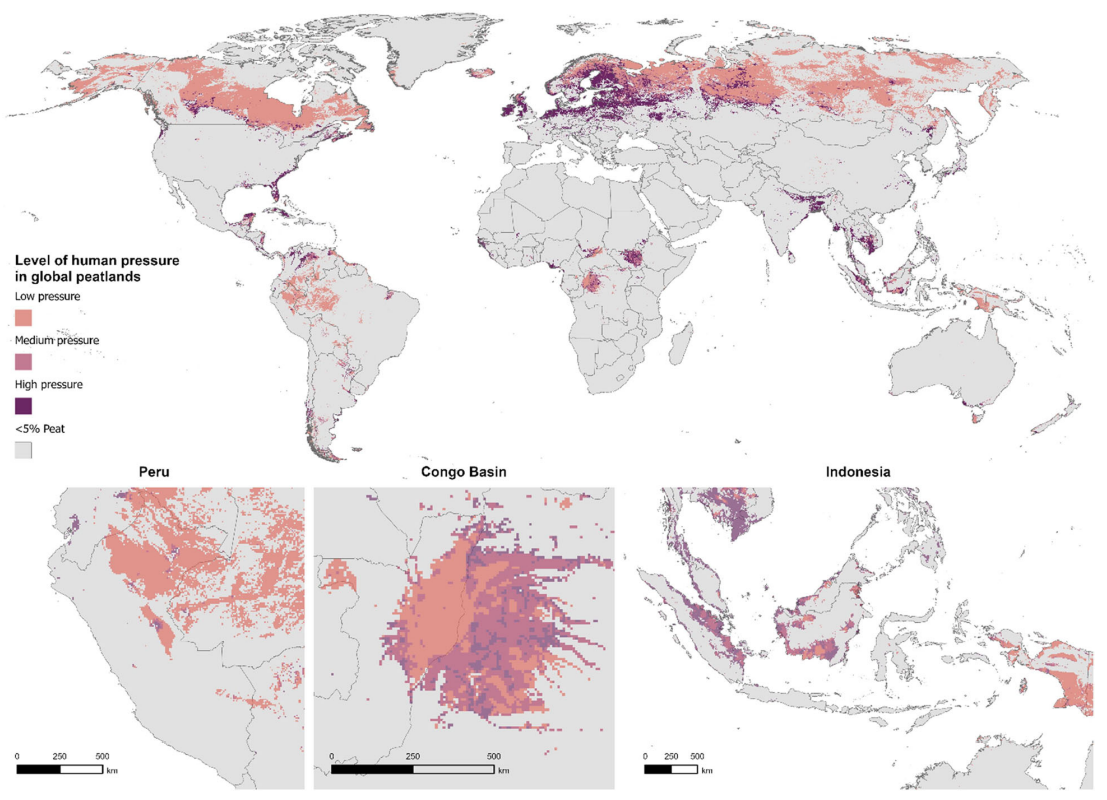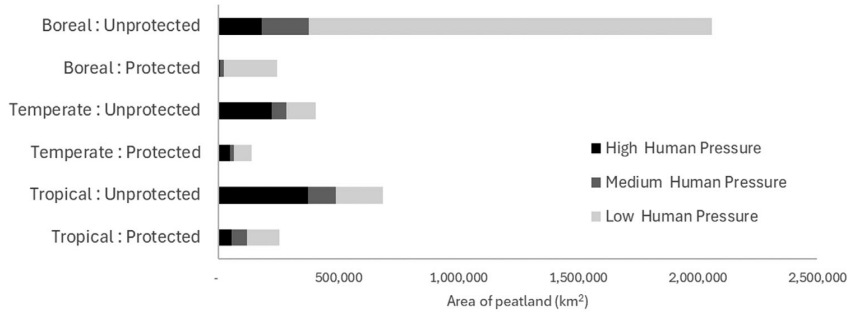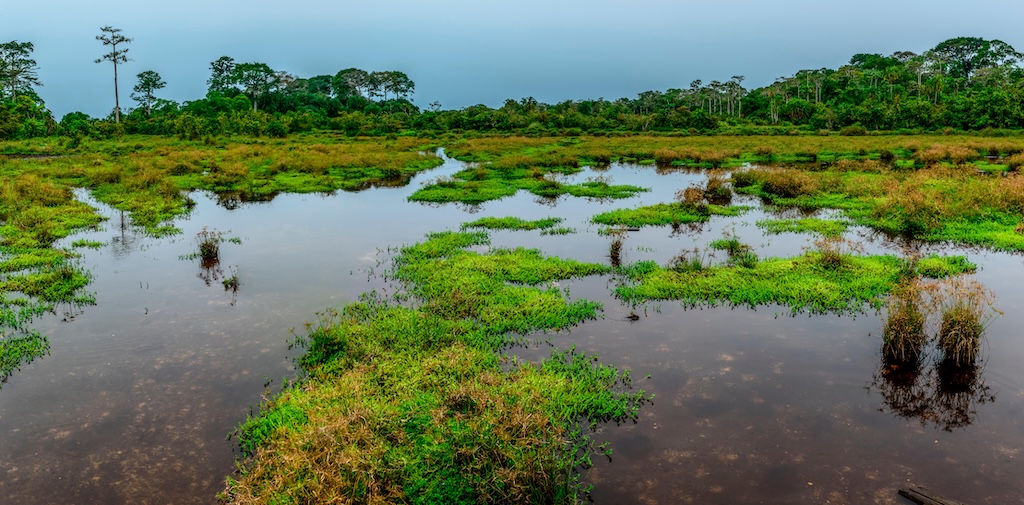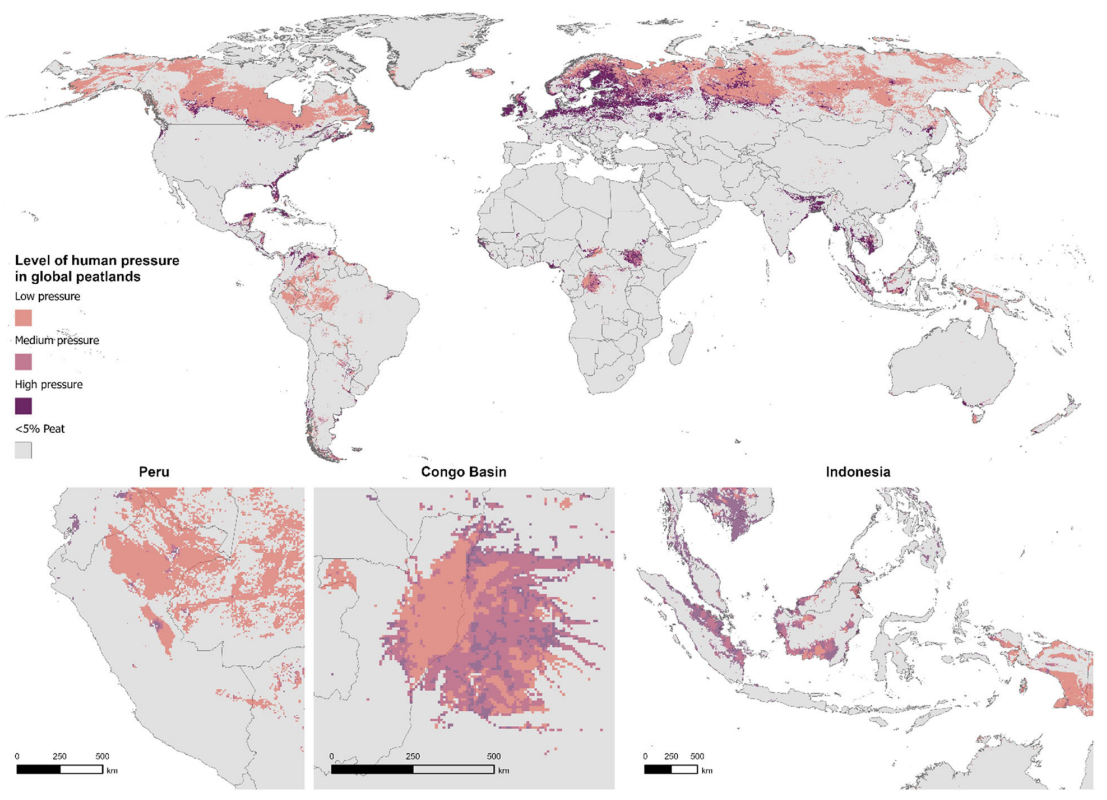There is a “mismatch” between the importance of peatlands and their current level of protection, a new study warns.
The paper, published in Conservation Letters, combines maps showing global peatlands, protected areas and human impact in the year 2020, to provide a snapshot of the current level of global peatland protection.
The authors stress that peatlands are crucial carbon stores, holding more carbon than all the world’s forest biomass combined.
However, they find that only 17% of peatlands fall within protected areas – a “substantially lower” proportion than other “high-value ecosystems”, such as mangroves, saltmarshes and tropical forests, they say.
The study finds that 22% of global peatlands are under “high human pressure”, with regions in Europe and the east coast of the US under particular threat.
Furthermore, one-third of the global peatlands in protected areas and Indigenous people’s lands still experience “medium to high human pressure”, the paper finds.
‘Disproportionate’ carbon stores
Despite peatlands’ relatively small footprint – they cover only 3% of the Earth’s land surface – the ecosystems store a “disproportionate amount” of carbon.
Research has shown that there is more carbon contained in peatlands than in all of the world’s forests combined – around 600bn tonnes (GtC).
They also provide myriad other “ecosystem services”, such as regulating air temperatures, storing water and creating habitat for many species.
Peatlands are wetland ecosystems that form slowly over time. When plant matter in one of these habitats dies, the high water content of the soils prevents it from decomposing completely.
As a result, plant matter accumulates, building up as carbon-rich peat over time. Peatlands are found on every inhabited continent, primarily in the high latitudes of the northern hemisphere and in the tropics.
The degradation and destruction of peatlands is a significant carbon source, contributing 2-4% of human-driven greenhouse gas emissions each year. Peatlands are often drained or degraded during use for agriculture, and about 16% of peatlands globally have been drained to date. In some places, peat is intentionally removed to be used as fuel or fertile soil.
Prof Chris Evans, a biogeochemist at the UK Centre for Ecology & Hydrology, who was not involved in the study, tells Carbon Brief:
“Peatland degradation is second only to tropical deforestation as a source of greenhouse gas emissions from land use, yet peatlands are often overlooked in conservation and climate policy.”
At the same time, climate change itself is putting peatlands at risk.
Increased temperatures are causing permafrost thaw, allowing the once-frozen peat to decompose and release CO2 into the atmosphere. Warmer temperatures also increase microbial activity, leading to faster rates of decomposition, while warmer, drier peatlands are more susceptible to fires.
Losing peatlands has “cascading effects on local water supplies, agriculture and fisheries, disproportionately affecting Indigenous and rural communities”, says Dr Michelle Kalamandeen, a geospatial scientist at McMaster University in Ontario, who was not involved in the study.
Protected areas
This study centres on an existing map of global peatland. The map divides the world into grid cells and, using a machine learning model trained on data collected on the ground, estimates the proportion of each cell that contains peatland at least 30cm deep.
The map identifies around 4m square kilometres (km2) of peatland globally. More than 60% of this is “boreal peatland” – found in the high-latitude northern regions, such as Canada, Russia and Scandinavia – and the rest is found in temperature or tropical regions, according to the study.
The authors then cross-reference the map with a database of global protected areas. The database encompasses both “strict” protection areas, such as national parks and nature reserves, as well as less strict land-management regimes where some human activity is permitted.
The database also shows Ramsar sites, a subset of protected areas designated to be of international importance under the Ramsar convention – also known as the “Convention on Wetlands”. (The convention seeks to promote “the wise use of all wetlands” in participating countries and encourage international co-operation with other countries.)
The authors find that only 17% of peatlands are located in protected areas. This is “substantially lower than other high-value ecosystems such as mangroves, 42% of which are within official protected areas globally, saltmarshes (50%) and tropical forests (38%)”, the study says.
Dr Kemen Austin is the director of science at the Wildlife Conservation Society‘s forests and climate change programme, and lead author of the new study. In a press release, she says that the study “reveals that these vital ecosystems don’t have anywhere near the level of protection they need”.
The authors also present case studies of individual countries. For example, they find that nearly 90% of peatland in the Republic of the Congo is protected. However, they warn that “most of this falls within a designated Ramsar site that has not yet been backed-up by strong government commitments”.
The study identifies a large body of literature showing that “Indigenous land rights and community-based management result in positive environmental outcomes, such as reduced deforestation and forest degradation”. The authors analyse data on Indigenous stewardship and find that one-quarter of global peatlands sit on land owned by Indigenous groups.
Human impact
The authors assess human pressures on peatland using the Human Impact Index (HII). This metric quantifies the “cumulative anthropogenic pressures” on a region, using a scale of 0-50 that incorporates factors such as accessibility, land use and population density.
The map below shows human pressure in areas that contain more than 5% peatland by area. Light pink shows “low-pressure” regions, medium pink shows “medium-pressure” regions and dark pink shows “high-pressure” regions.
The top map shows the whole planet, while the three inset maps below highlight chosen case studies in Peru, the Congo Basin and Indonesia.

The authors find that globally, 22% percent of peatlands are under high human pressure, 12% are under medium pressure and 61% are under low pressure. The remaining 5% are in areas without reported HII data.
The authors find that almost half of peatlands in temperate regions are facing high human pressure, adding that Europe and the US east coast are under particular stress. At the other end of the scale, they estimate that human pressure is low in Brazil, the lowlands of Peru, the Republic of the Congo and eastern Indonesia.
The study says that, as expected, human pressure is “somewhat higher” in unprotected peatlands than protected peatlands. However, it adds:
“Nearly one-third of global peatlands, and nearly half of temperate and tropical peatlands in protected areas and Indigenous people’s lands, still experience medium-to-high human pressure.”
The chart below shows the area of peatland in protected and unprotected boreal, temperate and tropical regions that is facing high (black) medium (grey) and low (light grey) human pressure.

Kalamandeen tells Carbon Brief that the study “underscores a fundamental disconnect between conservation priorities and real-world climate needs”.
However, she notes that there are some limitations to the methodology. For example, she tells Carbon Brief that the underlying peatland map “performs well in data-rich regions”, but says that “its accuracy drops where ground-truth data is lacking, notably in Africa, South America and boreal regions”.
Furthermore, the map only recognises peatlands deeper than 30cm, meaning that “shallower, but still ecologically valuable peatlands, are ignored”.
She continues:
“This study is an excellent starting point, but if we are serious about peatland protection, countries need to invest in better mapping and monitoring technologies such as using Earth observations and improving ground surveys to help refine conservation strategies.”
Peatland conservation
The new research “quantifies an issue that was previously known: that peatlands are under-protected when compared to other critical ecosystem types”, Dr Julie Loisel, a palaeoecologist at the University of Nevada, Reno, tells Carbon Brief. Loisel, who was not involved in the study, adds:
“In the face of rapid environmental change, ensuring that peatlands can ‘do their job’ of storing CO2 into their soils for the next few thousands of years is very important and any policy or land management effort that is enabling this simple goal should be put forth and prioritised.”
The study notes that several international policy frameworks, such as the global stocktake process under the Paris Agreement and the Kunming-Montreal Global Biodiversity Framework, can be applied to further the protection of wetlands.
For example, the authors note that Peru’s nationally determined contribution includes strategies for improving peatland management, such as establishing new conservation areas and recognising Indigenous peoples’ knowledge about peatlands.
However, Peru is one of the few countries with plans for the preservation of peatlands, alongside the UK, according to the study. Austin adds:
“Based on the nationally determined contributions countries have submitted to date, the continued disturbance and damage to global peatlands is getting very little attention as a significant and avoidable source of greenhouse gas emissions.”
In addition to protection of intact peatlands, peatland restoration “will be necessary for managing peat fires and meeting climate targets nationally”, the study says. Restoration typically involves altering the wetland’s water flows to “rewet” drained peat. It can also encompass controls on pollution, protection from burning and grazing and regrowing plants.

But while restoration can slow the release of CO2 and promote some ecosystem services, it is not an adequate substitute for peatland protection. The study notes:
“Notably, once emitted to the atmosphere, the carbon lost from peatlands cannot be restored on timescales that matter for preventing dangerous climate change.”
Promoting Indigenous peoples’ land rights is one way to support the protection of peatlands, Loisel says. She tells Carbon Brief:
“Conservation efforts do not necessarily imply ‘protection from use’, but are rather meant to ensure their ‘proper use’, or ‘sustainable use’. Indigenous community uses of peatlands have been known to be sustainable.”
Kalamandeen tells Carbon Brief that, while legal protections are “crucial”, their impact “depends on enforcement, management capacity and local engagement”. Meanwhile, she says that “Indigenous and community-managed lands, even without formal protection, often demonstrate strong conservation outcomes”.
Dr Adam Todd Hastie is the leader of the carbon and wetlands group at Charles University, and was not involved in the study. He agrees, calling Indigenous stewardship “often the best and most simple solution” to protecting peatlands.
However, he adds that global-north countries “need to be thoughtful in our calls for less economically developed countries to protect their peatlands”. He tells Carbon Brief:
“If we want less economically developed countries to take a different path of protecting their peatlands – and peat carbon – and to forgo short-term economic benefits, such as revenue from plantations or mining, we (especially Europe and North America) must contribute in real terms to developing alternative sustainable solutions, both environmentally and economically.”
The post Just 17% of world’s peatlands are protected, new study warns appeared first on Carbon Brief.





